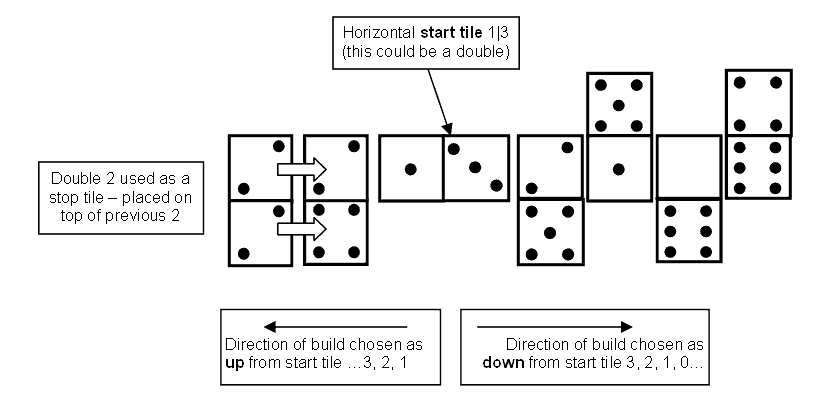Up-Down-Stop44
Introduction
Up-Down-Stop44 (Up-Down-Stop for four) is a 2 - 4 player version of the Up-Down-Stop domino patience game which uses the same basic format, however it involves a higher degree of decision making and therefore has a higher skill factor.
In this updated version, doubles can be used not only as stopping tiles (when they match the active tile) but also as a building tile. The method of scoring has been adapted to accommodate this change with the number of points for still having a Double reduced to 2pts from 5pts
Equipment
The game was designed and tested using a double six domino set, but other sets can also be used.
An Overview
In this game the players create a row of dominoes in which the number value of the domino is the important factor. Each domino is considered as two separate numbers, one of which is considered active and is built upon either up or down. At any one time only one row can be built upon. Doubles play a special role as they as used as stoppers to halt a row. The object is to have the least score after a number of hands.
The Play
The dominoes are placed face down and shuffled to form the draw pile.
Each player selects the appropriate number of tiles
4 players - 5 tiles 3 players - 6 tiles 2 players - 7 tiles
The starting player for the first hand is chosen at random. For subsequent hands the turn to start passes around the table from player to player.
The first player then has the opportunity to exchange up to two tiles from the draw pile. The discarded tiles are put to one side. Other players in order can also exchange tiles in a similar manner. Finally the discarded tiles and any remaining draw pile are shuffled together to make the draw pile used in the game.
To start the hand a tile from the draw pile is selected and placed horizontally. This may be a double.
The first player now has the option to play a tile on one end of the start tile. It is played vertically across the tile and numerically will either build up or down from the start tile. One side of the start tile must build up and the other down. The blank is counted as zero and so the order of tiles is 3, 4, 5, 6, blank, 1, 2, 3... when going up, and 3, 2, 1, blank, 6, 5, 4... when going down. If unable or unwilling to play a tile, the player passes and draws a tile from the draw pile.
The second player now has the following options
- play on the build-up end or play on the build-down end of the row or
- play a double as a stop tile on the first player’s tile providing numbers match or
- pass and pick up a tile
Note that a double can only be played against a vertical tile previously played by one of the players, never against the initial horizontal tile. Doubles match the active number on the tile they are stopping. Remember that a double can also be used as a normal building tile.
Players continue to play in turn. There are the following possibilities.
- play any tile to build on either the up or down end of the row or
- play a double as a stop tile, provided that it matches the tile on the end of the row and it is not the start tile or
- remove a stop tile and place it on the scrap heap, provided that the double was not played in the immediately previous turn or
- pass and pick up a tile if there are tiles remaining in the draw pile
A stop tile halts the row in that direction until the tile is removed. It must remain for at least the next player's turn, before being removed by any player after that as their turn. (Effectively the player after the person playing the double is stopped from playing on that end of the row as it blocks the building in that direction and they cannot remove it.) When a stop tile is removed it is placed face up in a "scrap heap" for all to see. This constitutes the player's turn. A double can only be used once during a game: the tiles in the scrap pile are not reused.
If a player cannot go or does not wish to play, then they draw a tile from the draw pile thus completing their turn. Tiles picked up are not played on that turn. Once the draw pile is used up a player who cannot or does not wish to play must just pass without drawing. If all players pass, then the hand ends.
Example

Scoring
When someone goes out by playing all their tiles or everyone passes the hand is over. Hands are scored as one point for each ordinary tile remaining in a player's hand and 2 points for each double. The person with the lowest score after a set number of hands is the winner, (for 4 players usually 4 or 8 hands - everyone starts a hand either once or twice).
Comments & Strategy
It is difficult to decide a strategy when tile swapping at the start of a game, though it is probably good to have an even distribution of numbers. If a hand contains too many doubles then it may or not be advantageous. Later on watching to see how many tiles other player have left and playing a double at the right moment may just win the hand.
Variations
Allow building in same direction on the initial tile e.g. both ends up or both ends down
Play as partners without discussion
Try Up-Down-Stop CrissCross and The Seven Pis (π). Any comments, suggestions or improvements please email
ChrisSmyth©2009